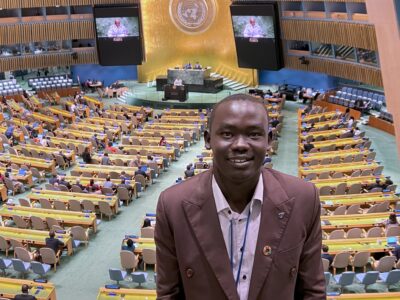
What are the responsibilities associated with your position?
In the founding stages, I was responsible for company launching, branding, growth strategy, and establishing vendor relationships. Today, I focus primarily on client relations and new business development, but given the start-up stage of the firm, I still find myself wearing many hats to keep the business running lean.
Do your current job responsibilities align with the professional goals that you originally had when you began the MSSM program?
Oh, absolutely. Coming from the wind energy business, I entered the MSSM program looking to get further entrenched in the world of sustainability and launch my own business. I was deciding between sticking with renewables or entering a new space like water or city/urban issues, while also having what I thought were irrelevant interests in interior design and plants. In my first semester of the MSSM program, this concept of green roofs popped up in three of my courses. Realizing green roofs transcended all the fields I thought I had to choose between immediately thrust me into deep, passionate, susty-nerd love.
What inspired you to work in sustainability?
Growing up just west of Toronto, I spent all four (extreme) seasons playing down in a ravine by my house – building tree forts, playing capture-the-flag, and catching salamanders in the creek (and hiking on top when it froze over). That was the real thing. I’ve only ever lived in massive urban centers since then, but I still ‘forest-bathe’ whenever I can.
In my mid-20s, I had the blessed opportunity of traveling the globe rather thoroughly, mainly in developing countries. Maybe it was just first-world guilt, but I returned home a changed man wanting more of a give-something-back vein in my career.
A few years later, I was in and out of the hospital, eventually diagnosed with kidney disease. The humility of the hospital staff and the impactfulness of their work had me regarding them as real life superheroes to be emulated. These three drivers (the forest, the travel, and the heroes) sent me in search of what I later learned was called a triple bottom line industry career path.
Urbanstrong offers me the chance to work in a field where I’m helping to protect and preserve the environment in ways that better the lives of people who live in cities and beyond (while earning money!).
How do you intend to utilize your degree from the MSSM program in furthering your career?
First, I use the wealth of knowledge that I gained from the MSSM degree to provide clients with the best solutions to sustainably meet their infrastructure needs. Second, I will continue to tap into MSSM’s rich alumni network. Urbanstrong can help MSSM alumni green their buildings and reduce their impact on the environment in ways that are also profitable for their companies (so that the VP of Finance is just as excited about their new green roof as the VP of Corporate Social Responsibility is). We also welcome MSSM students and alum to guest-write on the Urbanstrong blog on a range of related sustainability issues.
What has been your biggest challenge associated with sustainability in your current position?
I’ve had to learn to not sell to myself but rather get into my client’s shoes. To clarify, when pitching to a potential client, I’ve had to focus less on the environmental benefits of my company’s systems (which I instinctively want to lead with and gush on and on about) and stress more the financial benefits. While I may have gotten into this space for my own reasons, not everyone is willing to spend money to save a ravine. But, what they are willing to spend money on is something that brings a return on their investment.
What has been your biggest accomplishment associated with sustainability in your current position?
Helping prospective clients and vendors to see how to quantify all the benefits nature has to offer – in the context of integrating it into our cities and onto our buildings – always feels great. People innately get that nature is good and that maybe there’s room for improvement in a concrete jungle, but they’re usually not aware of the details. I enjoy the wide-eyed look in clients’ eyes when I walk them through the science and proof of all the ways that, for example, green rooftop gardens can improve our air & water, occupants’ physical and mental health, and even their marketing and P&L.
What skills has the MSSM program taught you that you think have proven useful to your current position?
Whether a corporation, health care facility, co-op, warehouse or restaurant, each of our clients benefits from green roofs and living walls in many ways – some more immediately obvious than others. To determine the total expected ROI of a given system, you must first quantify the value of each of the individual benefits – even the fluffy ones. Putting a dollar value behind ‘avoided future roof membrane replacements’ is more straightforward than say, ‘boosting employee focus or creativity.’ Professor Bose’s Cost Benefit Analysis class taught me approaches that we use here at Urbanstrong on a regular basis to help communicate a range of benefits in a way that a CFO can appreciate.
Also, I am fascinated by the power of geographic information system (GIS) software and its ability to collect, analyze, and present geographic data. It will be a great tool for client hunting, my extreme sport of choice these days.
What was your favorite class in the MSSM program and why?
Energy and Sustainable Development (SUMA K4150). Professor Phil LaRocco left me wishing it was the future so that I could Dropbox his brain – and its subfolders Experience, Knowledge, and Contacts – into my head. This course was all of sustainability compressed into one. It first introduced all the major renewable energy technologies and practices currently in use. Then it taught us how to evaluate a specific developing country to determine its needs, limitations, and opportunities for successful investment in a sustainable, impactful, development enterprise. Professor LaRocco’s teachings, generosity, and sense of humour were priceless to me.
What tips do you have for your fellow students who are looking for a job in sustainability?
Sustainability transcends just about every industry, and the range of courses available to MSSM students reflects this. If you’re not careful, this can add a challenge of focus when choosing a career path. To all course-shopping students, I say beware of shiny object syndrome; the dozens of fascinating classes that will capture your imagination and attention in such a way that you get distracted from the bigger picture (your career path story arc). Establish a potential space or story arc ASAP and become ‘that girl/guy’ in your year focused on that path, and make sure everyone knows it. Your classmates will forward you articles and job postings in “your” space as they come across them. Take courses that can be stitched together into your story. Even if you change your path later, it’s better than just having a history of random, unrelated courses that only really add up to several interesting talking points at cocktail parties.
What do you think is the most beneficial aspect of the MSSM program regarding your career?
The network. Without a doubt. What do you remember better from the last time you were in school… specific details about the subjects you studied, or the people you met? 90% of MSSM alumni found their post-MSSM jobs through their network. Admittedly, I made that number up, but it feels good. But seriously, employers prefer to hire through their own personal networks or using referrals from current employees. My advice to current students and any alum looking for a job: hit up all the MSSM events you can, and talk to everybody. Learn what they have done, what they do, what they hope to do. Listen. Build relationships. I guarantee there’s an attractive ROI there.
The M.S. in Sustainability Management, co-sponsored by the Earth Institute and Columbia’s School of Professional Studies, trains students to tackle complex and pressing environmental and managerial challenges. The program requires the successful completion of 36 credit points. Those credit points are divided among five comprehensive content areas: integrative sustainability management, economics and quantitative analysis, the physical dimensions of sustainability, the public policy environment of sustainability management, and general and financial management. Visit our website to learn more.



